

Pradal serey. Pradal Serey (Khmer: ប្រដាល់សេរី) or Kun Khmer (Khmer: គុណខ្មែរ) is an unarmed martial art from Cambodia.
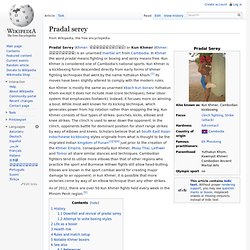
In Khmer the word pradal means fighting or boxing and serey means free. Kun Khmer is considered one of Cambodia's national sports. Kun Khmer is a kickboxing form descended directly from early forms of khmer fighting techniques that went by the name Yuthakun Khom.[1] Its moves have been slightly altered to comply with the modern rules. Kun Khmer is mostly the same as unarmed kbach kun boran/ Yuthakun Khom except it does not include mae (core techniques), tvear (door system that emphasizes footwork). Instead, it focuses more on winning a bout. As of 2012, there are over 50 Kun Khmer fights held every week in the Phnom Penh region.[5] History[edit] A scene depicting blocking a kick on a bas-relief from the Angkor region. Fighting has been a constant part of Southeast Asia since ancient times and eventually led to organized combat systems. Downfall and revival of pradal serey[edit] Rules. Khmer traditional wrestling. Khmer wrestling.
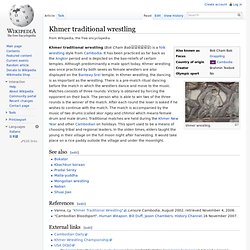
Khmer traditional wrestling (Bok Cham Babចំបាប់) is a folk wrestling style from Cambodia. It has been practiced as far back as the Angkor period and is depicted on the bas-reliefs of certain temples. Although predominantly a male sport today, Khmer wrestling was once practiced by both sexes as female wrestlers are also displayed on the Banteay Srei temple. In Khmer wrestling, the dancing is as important as the wrestling. There is a pre-match ritual dancing before the match in which the wrestlers dance and move to the music. See also[edit] References[edit] External links[edit] Kbach kun dambong veng. Kbach kun dambong veng (Khmer: ក្បាច់គុណដំបងវែង) is the term for a Cambodian martial art based on the long staff.
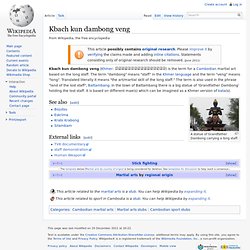
The term "dambong" means "staff" in the Khmer language and the term "veng" means "long". Translated literally it means "the art/martial skill of the long staff. " The term is also used in the phrase "land of the lost staff", Battambang. In the town of Battambang there is a big statue of 'Grandfather Dambong' holding the lost staff. It is based on different mae(s) which can be imagined as a Khmer version of kata(s).
A statue of Grandfather Dambong carrying a long staff. See also[edit] External links[edit] Kbach kun boran. See also[edit]
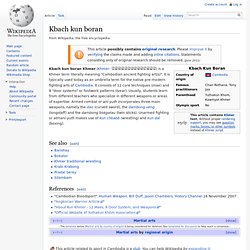
Bokator. Bokator, or more formally, Labokkatao (ល្បុក្កតោ) is a Cambodian martial art that includes weapons techniques.
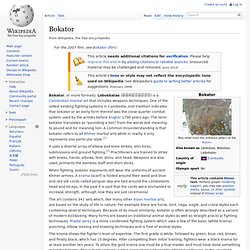
One of the oldest existing fighting systems in Cambodia, oral tradition indicates that bokator or an early form thereof was the close quarter combat system used by the armies before Angkor 1700 years ago. The term bokator translates as "pounding a lion" from the words bok meaning to pound and tor meaning lion. A common misunderstanding is that bokator refers to all Khmer martial arts while in reality it only represents one particular style.[1] It uses a diverse array of elbow and knee strikes, shin kicks, submissions and ground fighting.[2] Practitioners are trained to strike with knees, hands, elbows, feet, shins, and head. Weapons are also used, primarily the bamboo staff and short sticks. When fighting, bokator exponents still wear the uniforms of ancient Khmer armies. The krama shows the fighter’s level of expertise.
History[edit] Controversy[edit] See also[edit] Notes[edit]